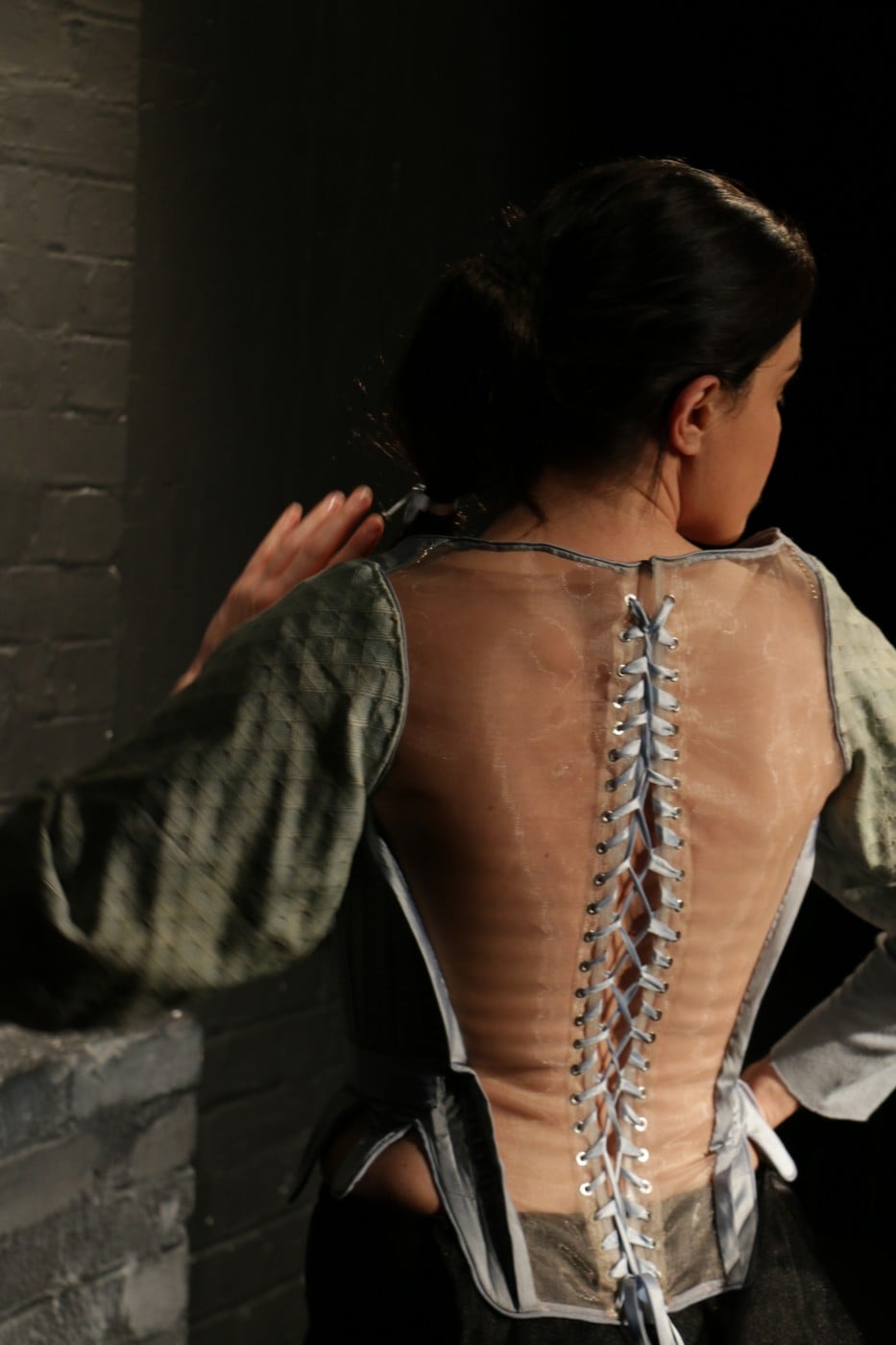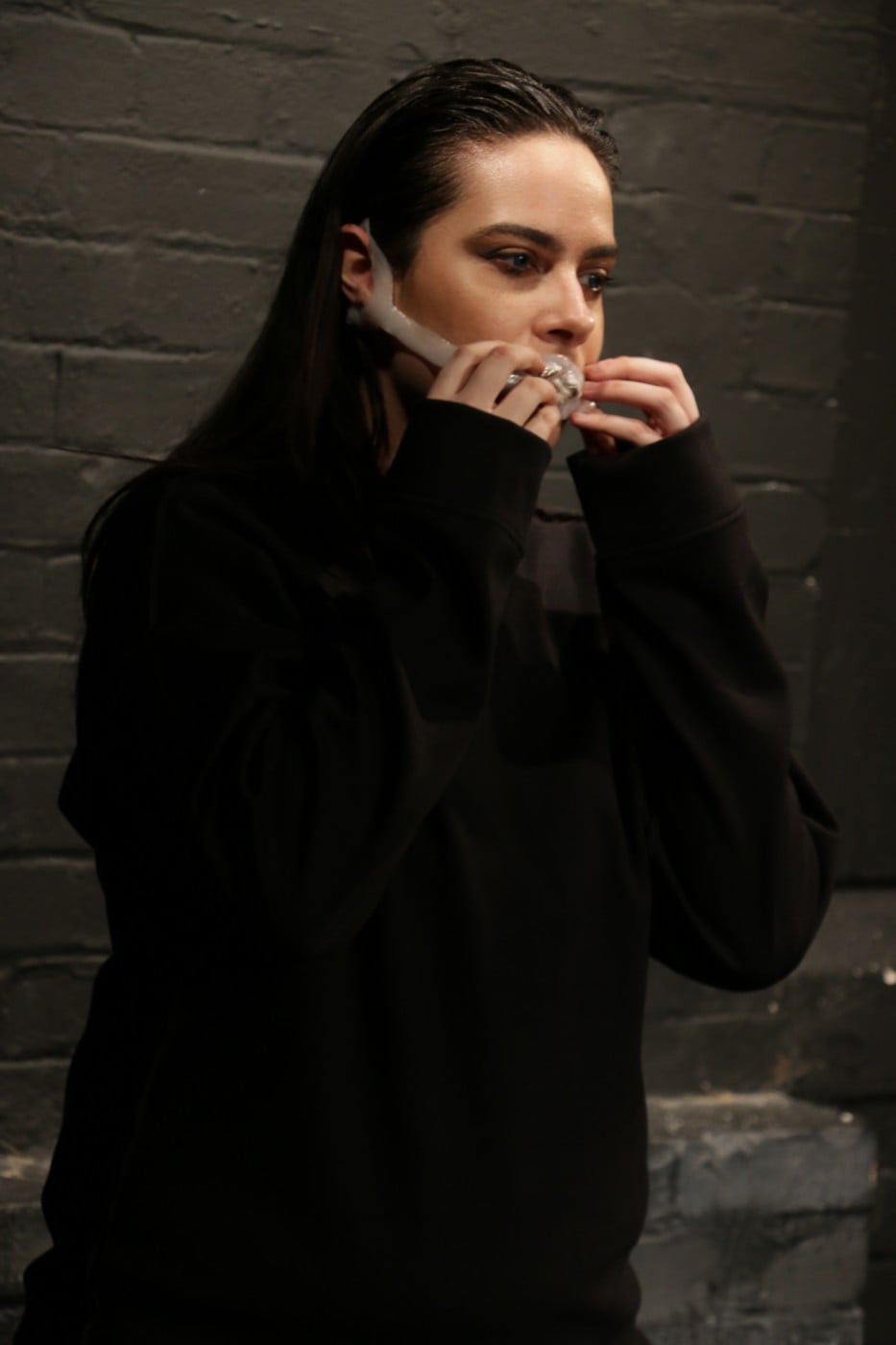
Last week saw Peckham’s Bussey Building host to ‘POST2018’, a fashion show which asked young designers to respond to a question: “How can can we utilise fashion to reconsider our environment?” The idea was to put students from eight different universities together and see how they would negotiate a vision of the world as it stands now through one of our oldest forms of expression: fashion. And what some of them came up with was bold, defiant and unexpected.
Imagine this: a pale girl, white t-shirt, bare faced, bare legged. She walks down a runway carrying, and enclosed within, her own chicken wire cage. A metallic embryo. This she carries in one hand and with the other she clasps a miniature TV screen, its display all white noise: a kind of ‘digital presence’. She peers out from behind it, as baffled and as fearful as her audience. She looks like a survivor. She is.
Surviving seems to have become the aim of our generation. We are overworked, overexposed, overanxious, overdigitised. We have been born, produced, trained, to be tired, to consume, to be tired again. So what has the girl with the chicken wire cage and her miniature TV screen come to tell us?

Nan’s look is impractical, definitely uncomfortable, perhaps as impractical and as uncomfortable as the pressure we exert on ourselves not to mention our environment. As a piece of “art” though, it’s inspired. The brainchild of third year Fine Art student Elly Foster at Arts University Bournemouth, it embodies the limbo between a digital and physical presence in an increasingly digitised world. Her concept was one concerned with post production, tearing materials from their “original form and purpose and re-create(ing) them” as “wearable materials” – a second chance – revitalisation. What she is is saying is quite clear. What will we do when we have have exhausted the resources we have? We probably won’t be wearing chicken wire cloak-cages… But then again, we might. This was a collection where Art met Fashion and had a love child, who then grew up and had a dystopian dream…
Nan was flanked by another model, who on first glance almost appeared nude. Her body was painted a washed-out lilac shade; her lingerie was functional. It was basic, sexless yet oddly sexual, a sex doll from a outer space. Expressionless, she towered above viewers on platform pink space-trainers. She made you want to reach forward and ask: “What happened here?”
So, ultimately, this is a question of sustainability. How do we learn to work with what we have? Elly takes it a step further saying she was “also inspired by potential dystopian futures”, possible worlds lightyears away which would result in having to marry “incompatible materials and utilise the utilitarian into new forms of materiality and purpose” – because with the way we are going, the horizons of the possible are broadening. So Elly’s baffled survivor, her lilac space doll, are unsettling but entrancing angels, they are future proof, heralds sent to remind us of our impending – and entirely self made – disaster.

The students that put their designs forward for POST2018 represented eight different universities from countries including Iceland, Germany, China and the UK. They were told to produce their designs using as little money as possible. Nic Locke, from New Forest, is in her second year studying Fashion Design and Development at London College of Fashion. Two years ago she found an abandoned tent whilst cycling through India. “I collect crap”, she said. The Indian tent she then crafted into a cape, and it walked down a runway in Peckham. A little evidently goes a long way, Nic. In truth the cape stands for something very sad, displacement. Nic wanted to find a way to acknowledge the refugee crisis caused by climate change, at a time when the world moving house. “And it’s only going to get worse.”
Her dynamic collection of six gave a character to each of our millennial problems. ‘The Shopper’ cruised down the runway pushing a Tesco’s trolley, his coat foiled from 48 plastic carrier bags. ‘Overpollution’ had a chest embellished with ring pulls from tin cans collected by Nic at various festivals and on the street. The point was hardly subtle, but what was striking was how effectively it was made. Nic’s “Mad max-esque” futuristic ‘Wondergirl’ was a celebration of the moment when androgyny meets femininity, and finds the feminine reasserting itself in a newly powerful way. Modelled by Caitlin, the Wondergirl, was again decked out in all found materials. She was quite a remarkable example of “crap” looking pretty sickkk. And Caitlin did not walk quietly. Both Nic and Elly’s pieces had an element of performance: the former a wildness, a youthful fervour, a sense of humour, while Elly’s pieces had a minimalism and a seriousness that caused the human model to disappear into the debris of the piece. Elly’s models were less human than the others; they were further away, disassociated… But that was precisely their great success as concepts.

German-born Penelope Koustantara, an aspiring costume designer, wanted to dress Lady Macbeth. She gave her sexuality, romance and something darker. Lady Macbeth’s psychodrama would be, the designer envisioned, dystopian. Penelope gave her models gowns of extreme and luxurious severity, bodices, corsets. The romantic flounce of the Victorian heightened the drama, brutally cut and slashed. Mordernised elegance, but quite deadly.
Lady Macbeth was a moment where this show proved itself to be a successful, articulate communicative project, just as its curator had hoped. When asked if he were happy with how the show turned out, Greek Goldsmiths student, Nikos Akritus, said simply: “Yes I definitely am!” He elaborated, saying that the highlight of having curated a project like this was seeing the designers and models exchange contacts and discuss working together in the future. For him, “This was the essence of the project”– to create a space for future fashion to be actively discussed.

As Elly’s heralds were living, breathing intellectual concepts, which engaged deliberately and quite radically in environmental and social dialogues, Nic and Penelope created pieces that spoke for fashion’s timelessness and the scope of fashion’s voice. Penelope’s designs carried familiar, nostalgic, highly feminine shapes; Nic’s catwalk crusaders were delinquents of a much more modern fairytale. However, both designers crafted outfits that reminded the onlooker of exactly how much clothes can actually say, and how many ways we can say what actually has to be said. Equally, Goldsmiths design student Louise Skajem, originally from Iceland, roped together outfits that recalled pirates and Caribbean witches. Her models dragged fabric sea creatures alongside them with string, a pirate boy wore a cardboard skirt, they were fun and fairylike. But underneath their charm Louise is drawing attention to our, by now long drawn out, theft from the ocean. Her question was: “What will happen if we give in to our vanity”?
There was another collaboration that brought societal quirks into the spotlight. Elena Board, Maja Nordblom and Lily Couchman from Goldsmiths added their under eye wear to Jerrold Jeon’s brand La Mode Chief. Jerrold’s impressive and assertive collection had a sharp edge of satire added to it with these pieces that can only be described as face jewellery. But these bizarre adages were in fact confronting the problem of our increasingly solipsistic and curated modern identities. The pieces hung from ear to the bridge of the nose, and were designed to hang under the eye to draw attention to one’s ‘bags’. The concept was to comment on our need to advertise our hectic, creative-project-filled life-styles, our overblown social and career aspirations. The more tired I look, the less I have slept, the more busy I am, the more I am affirmed – the more I exist. It was clever, cerebral and bang on point.

And that was not all. The show opened with a performance piece from Yaoer Zeng. It was a disturbing and repetitive interlude but it was a compelling anecdote on society, which consisted of Yaoer dragging stacked ceramic plates along behind her on extended geisha-esque trousers. The plates would inevitably fall off the trailing material, and the process of gathering them and restacking would repeat. It became claustrophobic as an introduction, but it gave the show a clear outline as to its meaning. However it would later highlight an essential disparity in the range of responses to the question organisers had asked: “How can can we utilize fashion to reconsider our environment?” It was not a question easily assigned to all of the designs on show; there were those collections that consisted quite simply of clothes that would sell, clothes that were not unlike what we see on the street now. But then there were those who in their approach to the subject abandoned the typical all together; and in a moment in time where surprises are rare, they brought something truly new, into an over saturated world.
The designers came from Goldsmiths, Central St. Martins, London College of Fashion, Kingston University, Arts University Bournemouth, Camberwell College of Art, Chelsea College of Art and Wimbledon College of Art.
Filed under: Fashion
Tagged with: Bussey Building, Elena Board, Elly Foster, fashion, fashion show, Lily Couchman, London, Louise Skajem, Maja Nordblom, Nic Locke, Nikos Akritus, Peckham, Penelope Koustantara



Comments